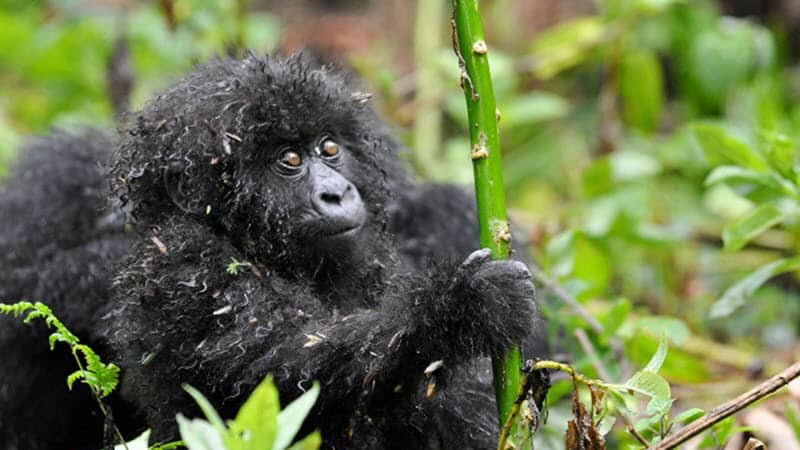Gorilla
Gorilla
Gorillas are the largest of the great apes. They are gentle giants, herbivores, and social creatures who share 98% of their genetic code with humans, making them our closest cousins after chimpanzees and bonobos. There are two gorilla species, separated geographically by expansive swaths of Congo Basin forest. The mountain gorilla is one of the rarest animals in the world with a growing population, but only about remaining 1,000 individuals. There are no captive mountain gorillas; any gorilla you see in the zoo is a lowland gorilla.
The safari industry in both Rwanda and Uganda is largely built around the mountain gorilla. There are a limited number of habituated groups, and also a limited number of trekking permits for each group on a daily basis ensuring that this remains one of the least-seen species in Africa.
The good news is holders of permits are almost assured sightings with virtually 100% success rates for treks. Once found, tourists have a one-hour viewing experience with the group. Each gorilla trekking group is limited to 8 participants, which allows for an intimate and high quality hour spent in the company of these incredible animals. Gorilla trekking difficulty can range from easy to strenuous in both Rwanda and Uganda, although Rwanda has more options on the easy to moderate level than Uganda.
Though the trekking permits are expensive (currently $1,500 per person per trek in Rwanda and $700 per person per trek in Uganda), gorilla trekking is considered by many to be the most intimate and amazing wildlife experience on the planet. If any safari activity could be considered priceless, this is it.
Lowland gorillas are more numerous, however there are only a few habituated groups limited to Loango National Park in Gabon and Odzala-Kokoua National Park in the Republic of Congo. Both parks are far off the beaten path and require extensive logistics to visit. the destinations are quite different from one another: Gabon is a fisherman’s paradise with wildlife frequently seen enjoying the ocean surf while the expansive Congo forests are a biodiversity utopia. Gorilla encounters are less predictable here than with mountain gorillas. Lowland gorillas are less habituated to humans and climb high into the trees while mountain gorillas do not.
Gorilla Itineraries
Gorilla Videos






Best Places to See Gorillas

The endangered mountain gorilla is found in only four national parks: Bwindi Impenetrable Forest and Mgahinga Gorilla National Parks in Uganda, Volcanoes National Park in Rwanda, and Virunga National Park in the DRC. Typically, trekking is a bit less strenuous in Rwanda, but both countries offer fantastic viewing experiences. For those looking for a quick add-on to other safari regions, the flight connectivity works to go directly from the Serengeti or Masai Mara to the gorilla trekking parks by regional flights, however both Rwanda and Uganda have much to offer the traveler on their own.
Other Areas of Note
Mgahinga Gorilla National Park sits on the border of Uganda and Rwanda. The landscape is closer to that of Rwanda’s Volcanoes National Park than Bwindi Impenetrable Forest. Only one habituated group is established in this park. There has been a second habituated group which relocated from Rwanda, but has not established itself permanently on the Uganda side. As such, it is not guaranteed that visitors to this park who opt for multiple gorilla treks will be able to visit different families within their permit zone.
Western lowland gorillas can be viewed in Loango National Park in Gabon, Dzanga-Ndoki National Park within the Central African Republic, and at Odzala National Park in Republic of Congo. The approximate success rate is 75% for each daily trek in the Congo and less in Gabon, but as these gorillas range further than mountain gorillas it can be more physically demanding as well.
Note: It is possible to do treks for mountain gorillas and eastern lowland gorillas in the Democratic Republic of Congo but due to unstable conditions we do not arrange trips to these locations.